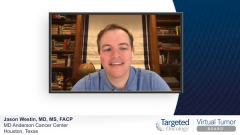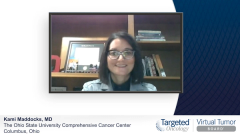
Case 3: Relapsed DLBCL, Double Hit
Jason Westin, MD, MS, FACP: This is the third case in our series, and this is a patient with relapsed large cell double hit. Our patient is 72 years old, and 15 months ago had stage IIIB large cell lymphoma. He didn’t feel well at presentation, with fatigue, night sweats, and a neck mass. The past medical history was notable for a cardiomyopathy with a relatively good ejection fraction of 48% percent. However, the creatinine clearance is impaired at 45 mL per minute. Your staging evaluation shows multiple sites of lymph nodes, including the neck, the mediastinum, the abdomen, and the retroperitoneum. The biggest site is 8 cm, so a rather significant disease burden.
Laboratory test results are notable for an elevated LDH [lactate dehydrogenase], and the lymph node biopsy shows large cell lymphoma, with the Hans algorithm showing the germinal center B-cell [GCB] subtype being present. FISH [fluorescence in situ hybridization] is performed, and you find the patient has both a MYC rearrangement as well as a BCL2 rearrangement. This would be reclassified as the so-called high-grade B-cell lymphoma with MYC and/or BCL2 or BCL6, double hit. CSF [cerebrospinal fluid test] is performed, evaluation with lumbar puncture, and is negative for lymphoma. The performance status is 1, and the IPI [International Prognostic Index] score is 3.
The patient is treated with a frontline approach of dose-adjusted R-EPOCH [rituximab plus etoposide, prednisone, vincristine, cyclophosphamide, hydroxydaunorubicin] for 6 cycles, and received CNS [central nervous system] prophylaxis with 4 cycles of intrathecal methotrexate. He has a complete response at the end of therapy by a PET [positron emission tomography]/CT, but unfortunately within a year develops a new mass, symptomatic, has night sweats. Performance status declines to 2; mild anemia, elevated LDH again; and your scan shows, again, significant adenopathy in the neck and the abdomen, with another bulky mass at 7 cm.
A biopsy is performed which shows, again, the same subtype of lymphoma, large-cell lymphoma, GCB subtype, which is likely the same double hit disease that this patient had earlier that year.
You treat the patient with R-GDP [rituximab plus gemcitabine, dexamethasone, cisplatin], and after 3 cycles perform a PET scan showing, unfortunately, progressive disease in the site seen previously, and again perform a biopsy showing the same disease: relapsed/refractory double-hit diffuse large B-cell lymphoma.
Transcript edited for clarity.















































